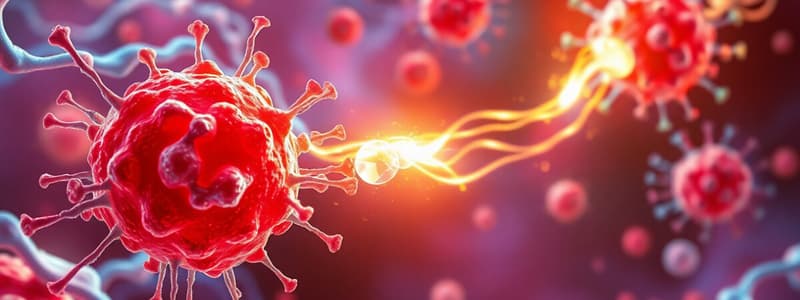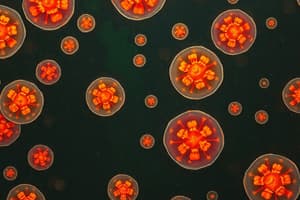Podcast
Questions and Answers
What is the primary role of MHC molecules in the immune system?
What is the primary role of MHC molecules in the immune system?
- To bind and display peptides for T cell recognition. (correct)
- To regulate the growth of T cells in the lymph nodes.
- To produce antibodies for antigen neutralization.
- To capture and destroy pathogens directly.
Which class of MHC molecules is found on all nucleated cells?
Which class of MHC molecules is found on all nucleated cells?
- MHC III
- MHC I (correct)
- MHC IV
- MHC II
Which of the following cells are primarily considered antigen presenting cells (APC)?
Which of the following cells are primarily considered antigen presenting cells (APC)?
- Red blood cells
- Neutrophils
- Killer T cells
- B cells, macrophages, and dendritic cells (correct)
What is the significance of MHC polymorphism in the immune response?
What is the significance of MHC polymorphism in the immune response?
Which T cell subtype is primarily activated by MHC II molecules?
Which T cell subtype is primarily activated by MHC II molecules?
What role do dendritic cells play in T cell activation?
What role do dendritic cells play in T cell activation?
What regions of class I MHC molecules contain polymorphic residues responsible for peptide binding variations?
What regions of class I MHC molecules contain polymorphic residues responsible for peptide binding variations?
Which class of MHC molecule accommodates longer peptides due to its open cleft structure?
Which class of MHC molecule accommodates longer peptides due to its open cleft structure?
In which locations of MHC class II molecules are polymorphic residues found?
In which locations of MHC class II molecules are polymorphic residues found?
What is the primary function of anchor residues of peptides in relation to MHC molecules?
What is the primary function of anchor residues of peptides in relation to MHC molecules?
What is the role of mechanisms of antigen processing in relation to MHC molecules?
What is the role of mechanisms of antigen processing in relation to MHC molecules?
Which of the following best describes the closure of the cleft in class I MHC molecules?
Which of the following best describes the closure of the cleft in class I MHC molecules?
What is the primary role of antigen-presenting cells (APCs) in T cell activation?
What is the primary role of antigen-presenting cells (APCs) in T cell activation?
Which type of T cells are primarily activated by macrophages and B lymphocytes?
Which type of T cells are primarily activated by macrophages and B lymphocytes?
What are co-stimulators in the context of T cell activation?
What are co-stimulators in the context of T cell activation?
How do dendritic cells capture antigens from their environment?
How do dendritic cells capture antigens from their environment?
What cytokine is important for activating dendritic cells in response to microbes?
What cytokine is important for activating dendritic cells in response to microbes?
When activated, dendritic cells express a chemokine receptor that allows them to migrate to which part of the lymph nodes?
When activated, dendritic cells express a chemokine receptor that allows them to migrate to which part of the lymph nodes?
What is the function of adjuvants in the immune response?
What is the function of adjuvants in the immune response?
What occurs to dendritic cells upon activation by cytokines?
What occurs to dendritic cells upon activation by cytokines?
What must happen for CD8+ T cells to recognize and kill virus-infected cells?
What must happen for CD8+ T cells to recognize and kill virus-infected cells?
What is the role of mature dendritic cells (DCs) in T cell activation?
What is the role of mature dendritic cells (DCs) in T cell activation?
Which class I MHC genes are present in humans?
Which class I MHC genes are present in humans?
What is true about MHC polymorphism?
What is true about MHC polymorphism?
What type of polypeptides compose each class II MHC molecule?
What type of polypeptides compose each class II MHC molecule?
What does the term 'MHC haplotype' refer to?
What does the term 'MHC haplotype' refer to?
Where are MHC genes located in humans?
Where are MHC genes located in humans?
How do T cells recognize antigens?
How do T cells recognize antigens?
What is required for T cell antigen recognition to occur?
What is required for T cell antigen recognition to occur?
Flashcards are hidden until you start studying
Study Notes
MHC Molecules
- MHC molecules bind and display peptides for recognition by CD4+ and CD8+ T cells
- MHC recognition is essential for T cell maturation, ensuring that mature T cells only recognize MHC molecules with bound antigens
- MHC molecules are highly polymorphic, meaning they vary between individuals, influencing both peptide binding and T cell recognition
Antigen Presenting Cells (APCs)
- APCs capture antigens from their site of entry or production and deliver them to lymphoid organs where naive T lymphocytes reside
- APCs express class II MHC molecules and other molecules involved in stimulating T cells, capable of activating CD4+ T lymphocytes
Types of APCs
- Dendritic cells are the most effective APCs for activating naive T cells and initiating T cell responses
- Macrophages and B lymphocytes are more effective for previously activated CD4+ helper T cells rather than naive T cells
Functions of APCs
- Antigens are the first signal for activating naive T cells, while co-stimulators act as second signals for activation
- Co-stimulators are membrane-bound molecules on APCs that work alongside antigens to stimulate T cells
- Adjuvants, derived from microbes, enhance the expression of co-stimulators and cytokines, also stimulating the antigen-presenting functions of APCs
Role of Dendritic Cells
- Some antigens are transported in the lymph by APCs (primarily DCs) who capture the antigen and enter lymphatic vessels
- Antigens that enter the bloodstream can be sampled by DCs in the spleen, or captured by circulating DCs and taken to the spleen
- Resting tissue-resident DCs use receptors, like C-type lectins, to bind and endocytose microbes or microbial proteins, processing the ingested proteins into peptides capable of binding to MHC molecules
- DCs can ingest antigens through pinocytosis, which does not involve specific recognition receptors, internalizing molecules in the vicinity of DCs
- DCs are activated by cytokines, such as TNF, produced in response to microbes. Activated DCs (also called mature DCs) lose their adhesiveness for epithelia or tissues, and begin to express CCR7, a chemokine receptor specific for CCL19 and CCL21, chemokines produced in lymphatic vessels and T cell zones of lymph nodes
Dendritic Cells in Antigen Capture and Presentation
- DCs are strategically located at common entry sites of microbes and foreign antigens (in epithelia) and in tissues colonized by microbes
- DCs express receptors that enable them to capture and respond to microbes
- DCs migrate from epithelia and tissues via lymphatics to T cell zones in lymph nodes where naive T lymphocytes circulate
- Mature DCs express high levels of peptide-MHC complexes, co-stimulators, and cytokines, all necessary to activate naive T lymphocytes
MHC Discovery
- If a mouse is infected with a virus, CD8+ T cells specific for the virus are activated and differentiate into CTLs. Analyzing the function of these CTLs in vitro, they recognize and kill virus-infected cells only if the infected cells express MHC molecules expressed in the animal from which the CTLs were removed
- T cells must be specific for both the antigen AND MHC molecules. T cell antigen recognition is restricted by the MHC molecules a T cell sees.
MHC Genes
- Polymorphic class I and class II MHC molecules are the ones responsible for displaying peptide antigens for recognition by CD8+ and CD4+ T cells, respectively.
- The products of different MHC alleles bind and display different peptides, meaning different individuals may present different peptides even from the same protein antigen
- For a given MHC gene, each individual expresses the alleles inherited from both parents, maximizing the number of MHC molecules available for binding peptides and presenting them to T cells
Human MHC Genes
-
In humans, the MHC is located on the short arm of chromosome 6, occupying a large segment of DNA (approximately 3500 kb)
-
There are three class I MHC genes called HLA-A, HLA-B, and HLA-C, which encode three types of class I MHC molecules with the same names
-
There are three class II HLA gene loci called HLA-DP, HLA-DQ, and HLA-DR. Each class II MHC molecule is composed of a heterodimer of α and β polypeptides.
-
The set of MHC alleles present on each chromosome is called an MHC haplotype
### Polymorphic Residues of MHC Molecules -
The polymorphic residues of class I molecules are confined to the α1 and α2 domains, contributing to variations among different class I alleles in peptide binding and T cell recognition.
-
The polymorphic residues of class II molecules are located in the α1 and β1 segments, in and around the peptide-binding cleft, similar to class I MHC molecules.
### Peptide Binding to MHC Molecules -
The class I molecule shown is HLA-A2, and the class II molecule is HLA-DR1. The cleft of the class I molecule is closed, while the cleft of the class II molecule is open. As a result, class II molecules accommodate longer peptides than class I molecules.
-
Side view of a peptide bound to a class II MHC molecule shows how anchor residues of the peptide hold it in the pockets of the MHC molecule cleft.
### Processing of Protein Antigens -
Antigen processing mechanisms are designed to generate peptides with structural characteristics necessary for associating with MHC molecules, placing these peptides in the same cellular location as newly synthesized MHC proteins with available peptide-binding clefts.
-
Cytosolic proteins are degraded by proteasomes to yield peptides displayed on class I MHC molecules, while proteins ingested from the extracellular environment and sequestered in vesicles are degraded in lysosomes (or late endosomes) to generate peptides presented on class II MHC molecules
Class I MHC Pathway for Processing and Presentation of Cytosolic Proteins
- Microbial proteins in the cytosol that undergo proteasomal degradation are derived from microbes (usually viruses) that replicate and survive in the cytosol, extracellular bacteria that inject proteins into the cytosol, and various extracellular organisms that are phagocytosed, with their proteins transported from vesicles into the cytosol
- Degradation of proteins in proteasomes generates peptides capable of binding to class I MHC molecules
- Peptides generated by proteasomes in the cytosol are translocated by a specialized transporter (TAP) into the ER, where newly synthesized class I MHC molecules are available to bind the peptides.
- Class I MHC molecules with bound peptides are structurally stable and are expressed on the cell surface.
Class II MHC Pathway for Presentation of Proteins Degraded in Lysosomes
- Most class II MHC-associated peptides are derived from protein antigens digested in endosomes and lysosomes in APCs.
- Internalized proteins are degraded enzymatically in late endosomes and lysosomes to generate peptides capable of binding to the peptide-binding clefts of class II MHC molecules.
Studying That Suits You
Use AI to generate personalized quizzes and flashcards to suit your learning preferences.



